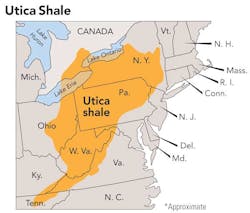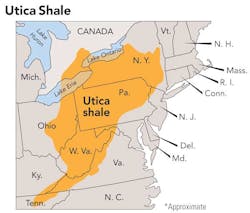Utica vs. Eagle Ford
Don Warlick, WarlickEnergy
Analysts say that the Utica Shale, which is nearly equal to the size of the Eagle Ford play in Texas, could become the third-largest shale play in the United States, producing as much as 250,000 to 500,000 barrels of oil a day. The Ohio Department of Natural Resources estimates that the Utica's potentially recoverable reserves could range from 3.75 TCF of gas and 1.31 billion barrels of oil to 15.7 TCF gas and 5.5 billion barrels of oil.
In comparing the Utica to the Eagle Ford, the following: True vertical depth (TVD) in the Utica can be as shallow as 4,500 feet versus ~ 6,000 feet in the Eagle Ford, recovery factor can be 5% versus 4%, formation thickness 140 feet versus an average of 100 feet and porosity of 8% versus 5-8% in the Eagle Ford.
With regard to activity and players here is what's happening so far:
- Chesapeake holds more than 1 million net acres in the Utica and is by far the most active driller with a total of 87 wells with plans to finish 2012 with 15 operated rigs. The company has significant funds to support development through the end of 2014 thanks to the remaining drilling carry from the January 2012 joint venture with Total.
- After Chesapeake released data for five wells drilled in Carroll and Harrison Counties in the Utica/Point Pleasant play earlier in the year, everyone took notice. The Buell well IP was 9.5 MMCFED of gas, 150 BD of condensate, and 1,275 BD of NGLs for a total of 1,040 BOED.
- Then came Gulfport Energy's Wagner 1-28H well in Harrison County producing 14 MMCFED of dry natural gas and 1,881 BD of natural gas liquids (after processing) along with 432 barrels of oil, significantly higher than the IP rate of Chesapeake's Buell well. Gulfport plans to drill 200 wells in the area in the next four years.
- There are other big players here also: BP has invested, then there's Hess and CONSOL who entered into a 50/50 joint venture a year ago valued at almost $600 million to fund drilling and development across 200,000 acres.
And there is more activity when it comes to deals taking place in the Utica involving acquisitions and infrastructure as indicated by the following examples:
- EnerVest Ltd. amassed a huge collection of Utica drilling rights beginning in 2003 with plans to harvest their investment. Accordingly, they plan to sell drilling rights to about 70% of the acreage and retain slightly more than 200,000 net acres whose potential will be determined in the future. It's estimated this sale could generate more than $6 billion.
- In September, Spectra Energy, EnBridge and DTE Energy formed a Utica pipeline joint venture with plans to commence operations by late 2015 depending upon demand at that time. Total investment for this new pipeline system is estimated at $1.2 billion to $1.5 billion.
- Also in September, NiSource and Hilcorp Energy announced a joint venture to construct the Pennant Midstream gathering pipeline infrastructure with NGL processing in Northeast Ohio/Western Pennsylvania. Reportedly it will cost around $300 million.
Summary
There are more announced (and unannounced) deals and plans that will be adding to Utica momentum, supporting a transition from early-stage to a bigger development opportunity that will probably rank with the big shale plays in the future. It will depend, of course, on continuing investment by larger players like Chesapeake, Hess, BP, CONSOL and others plus the near-term economics of crude oil and liquids to affirm a logical path forward in Utica development.
About the author
Don Warlick is president of WarlickEnergy (www.warlickenergy.com), a Houston-based energy intelligence firm. The company publishes a series of special reports on each of the leading US unconventional shales and also provides market research services addressing North American and International oil & gas markets.


